A large number of single nucleotide variants have been associated with important agronomic traits and used in crop improvement. Genetic engineering of single nucleotide polymorphisms in plants represents a great advance in molecular breeding. Base editors (BEs) generate programmable base changes without requiring DNA double-strand breaks (DSBs) or exogenous donor DNA. The most widely used base editor, BE3, which consists of the cytidine deaminase rat APOBEC1 fused with a Cas9 nickase (nCas9 (D10A)) and the uracil glycosylase inhibitor (UGI), converts targeted C to T in genomic DNA. However, the genome target scope of BE3 is still restricted by a narrow deamination window (five base pairs). Moreover, it has a striking preference for TC and substantially decreased activities for GC context. All these limitations affect the ability of base editors to generate precise mutations and corrections in plant genomes.
Recently, a research team led by Prof. GAO Caixia in the Institute of Genetics and Developmental Biology of Chinese Academy of Sciences reported that a new plant base editor, human APOBEC3A-based BE (A3A-PBE), converts C-to-T efficiently in wheat, rice and potato with a 17-nucleotide editing window at all examined sites.
In this study, the researchers applied the A3A-PBE system to target twenty different target sites of endogenous wheat, rice and potato genes in protoplasts, and the results showed that A3A-PBE substitutes Cs to Ts at the average frequency of 13.1%, 13-fold higher than their previously established rat APOBEC1-based PBE (Zong et al, Nat. Biotechnol, 2017). The A3A-PBE deamination window typically spanned from position 1 to 17 within the protospacer, and importantly, it could efficiently target regions with GC dinucleotide, independent of sequence context, which will make a significant improvement in targeting scope.
Furthermore, the TaALS, TaMTL, OsCDC48, OsNRT1.1B-T1 and StGBSS-T6 were selected to transform to the relevant plants, and the point mutation frequencies were up to 82.9%.
This is the first time to report cytidine deamination base editing could be applied to target the potato genome. A novel gain-of-function mutation created in the ALS gene of wheat by A3A-PBE makes the wheat herbicide-tolerant, underlining the great potential of this method for molecular breeding in plants.
A3A-PBE generated C to T conversions efficiently at a broad range of endogenous genomic loci within a 17nt deamination window. It works well for all cytidines regardless of their genomic context, and can create a diverse repertoire of mutations in coding and non-coding regions.
“We believe that the A3A-PBE represents an appealing tool for producing the precise mutations and diverse genetic variants valuable in plant breeding, thus helping to increase the efficacy of crop improvement through genome engineering”, said Dr. GAO.
This research was supported by the National Natural Science Foundation of China, the National Transgenic Science and Technology Program, as well as the Chinese Academy of Sciences.
Figure: The scope of cytidine base editing by A3A-PBE (Image by IGDB)
 Figure: The scope of cytidine base editing by A3A-PBE (Image by IGDB)
Figure: The scope of cytidine base editing by A3A-PBE (Image by IGDB) CAS
CAS
 中文
中文




.png)
